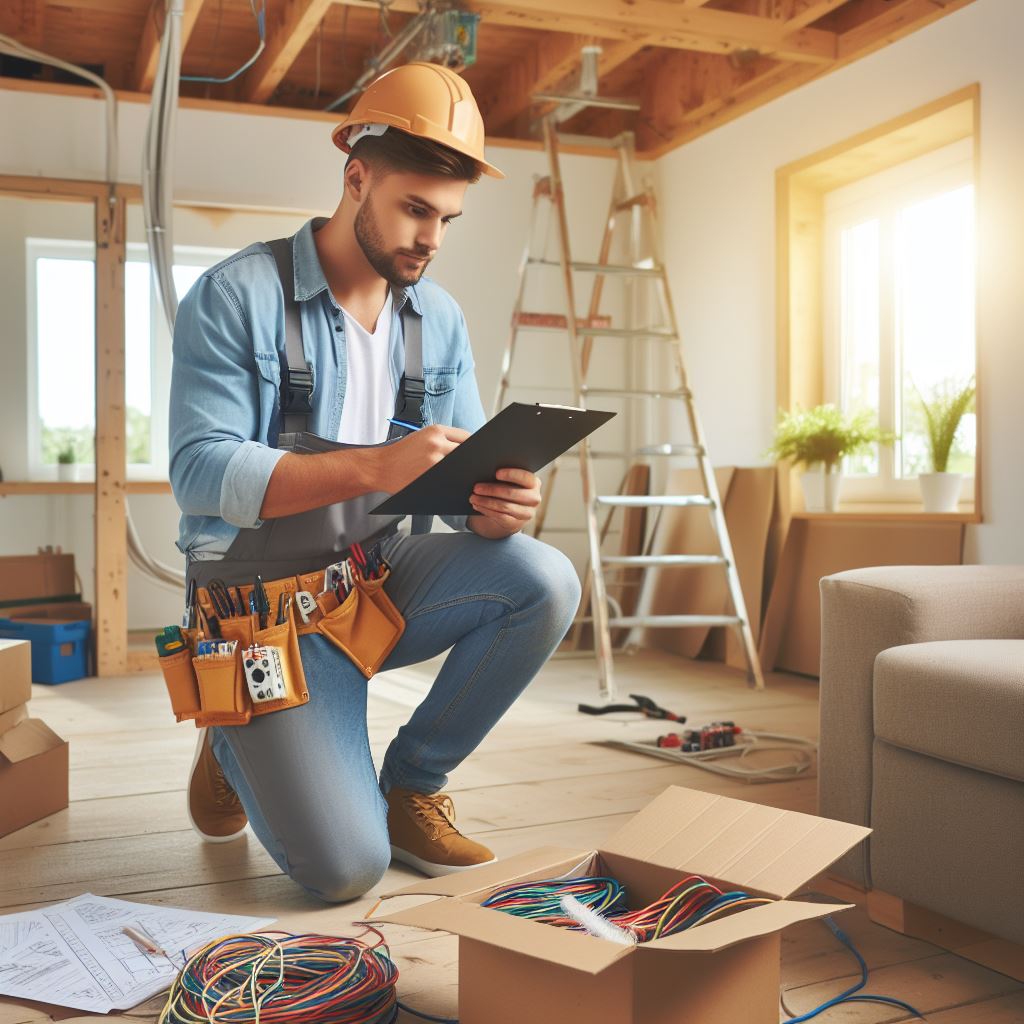Introduction
Home inspections are crucial to ensure the safety and functionality of a property.
In this blog post, we will specifically discuss the essential electrical must-checks during a home inspection.
The following sections will cover potential electrical issues, safety precautions, and signs of faulty wiring.
Electrical Panel Assessment
During a home inspection, an important step is to examine the electrical panel for any defects or hazards.
The inspector will ensure that the panel is properly labeled and that all breakers are functioning correctly.
They will also check for signs of overheating, corrosion, or loose connections within the panel.
Wiring Inspection
Inspectors will closely examine the wiring throughout the property to identify any potential safety concerns.
They will assess for exposed wires, outdated or damaged wiring, and improper electrical connections.
Additionally, they will check for the presence of grounding wires and the use of appropriate electrical outlets.
GFCI Outlets
Ground Fault Circuit Interrupter (GFCI) outlets are essential safety features in areas prone to water exposure.
Inspectors will test these outlets to ensure they function properly and provide effective ground fault protection.
They will also verify the presence of GFCI outlets in appropriate locations like bathrooms, kitchens, and outdoor areas.
Smoke and Carbon Monoxide Detectors
An important part of the electrical inspection is to confirm the presence of working smoke and carbon monoxide detectors.
Inspectors will test these devices to ensure they are operational and strategically placed throughout the property.
In essence, conducting a thorough electrical inspection is crucial to identify potential hazards and ensure the safety of a home.
Transform Your Real Estate Decisions
Unlock personalized real estate insights crafted just for you. Get actionable advice designed to amplify your success.
Get StartedInspectors must pay close attention to the electrical panel, wiring, GFCI outlets, and smoke/carbon monoxide detectors.
By addressing any electrical issues during the inspection, homeowners can proactively maintain a safe living environment.
Understanding the Electrical System
Basic understanding of residential electrical systems
The electrical system in a home is responsible for supplying power to appliances, lights, and other electrical devices.
It consists of a network of wires, cables, circuit breakers, and outlets that distribute electricity throughout the house.
A residential electrical system typically includes a main service panel, subpanels, branch circuits, and grounding equipment.
Understanding the basics of how these components work together is crucial for any homeowner.
Knowledge of electrical systems helps in troubleshooting common issues and ensures safety.
Safety hazards associated with faulty electrical systems
A faulty electrical system poses various safety hazards, such as electric shocks, electrical fires, and electrocution.
Old or damaged wiring, improper installations, and overloaded circuits are common culprits for electrical hazards.
Exposed wires, outlets, or switches can also be dangerous, especially for children and pets.
Ignoring these hazards can lead to serious injuries or even fatal accidents.
Regular inspections and maintenance of the electrical system are essential to prevent such hazards.
Importance of hiring a licensed electrician
When dealing with electrical issues, it is crucial to hire a licensed and experienced electrician.
Licensed electricians have undergone proper training, possess necessary skills, and follow safety guidelines.
Showcase Your Real Estate Business
Publish your company profile on our blog for just $200. Gain instant exposure and connect with a dedicated audience of real estate professionals and enthusiasts.
Publish Your ProfileThey are knowledgeable about electrical codes and regulations, ensuring compliance and avoiding potential legal issues.
Hiring a licensed electrician also guarantees professional workmanship and quality results.
Attempting to fix electrical problems without proper knowledge and skills can be risky and may worsen the situation.
In fact, understanding the electrical system is essential for homeowners to ensure safety and prevent accidents.
Having a basic understanding of residential electrical systems allows individuals to troubleshoot common issues and identify potential hazards.
Faulty electrical systems can pose various safety risks, including electric shocks and fires.
It is crucial to address these hazards promptly through regular inspections and maintenance.
Hiring a licensed electrician is highly recommended as they possess the necessary knowledge, skills, and expertise to handle electrical work safely and efficiently.
Attempting to fix electrical problems without proper experience can lead to further damage and potential accidents.
By prioritizing the safety of the electrical system in our homes, we can protect ourselves, our loved ones, and our property from electrical hazards.
Read: Home Buying: Unlocking Powerful Negotiation Skills
Exterior Electrical Components
When it comes to conducting a comprehensive home inspection, paying attention to the electrical system is paramount.
Faulty electrical components can pose serious risks such as fire hazards or electric shock.
Therefore, it is essential to perform thorough checks both indoors and outdoors.
Inspection of electrical service entrance
- Check the condition of the meter box and ensure its grounding: The meter box should be in good condition, free from any damage or corrosion.
Additionally, it should have a proper grounding system in place to prevent electrical accidents. - Examine the service entrance cables and determine the state of their insulation: Look for any signs of wear or damage on the cables.
Ensure that the insulation is intact and not frayed, as it provides essential protection against electrical shock.
Inspection of electrical panels
- Verify proper labeling on the electrical panels and ensure clear access to them: Each circuit breaker should be accurately labeled to facilitate easy identification and troubleshooting.
Additionally, there should be clear space around the panels for safe and convenient access. - Check for signs of overheating, corrosion, or loose connections in the panels: Inspect the panels for any indications of overheating, such as discoloration or melting.
Look for corrosion on the panels and ensure that all connections are properly tightened to minimize the risk of electrical malfunctions.
Outdoor electrical outlets and junction boxes
- Verify the functionality and safety of outdoor electrical outlets: Test each outdoor outlet with a reliable electrical testing device to ensure it is working correctly.
Additionally, check for signs of damage or exposed wiring that may pose a safety threat. - Ensure proper protection against the elements for the outlets and junction boxes: Make sure that outdoor outlets and junction boxes are adequately sealed to protect them from rain, snow, or other outdoor elements.
Improper protection can lead to electric shock or short circuits.
By conducting a thorough inspection of the exterior electrical components, you can identify any potential hazards and rectify them promptly.
Remember, electrical safety is crucial in maintaining a secure and hazard-free living environment.
Always consult a professional electrician if you encounter any significant issues during the inspection process.
Read: Home Inspection Insights for First-Time Buyers

Interior Electrical Components
When conducting a home inspection, it is crucial to thoroughly examine the interior electrical components.
This step is significant to ensure the safety and functionality of the electrical system within the house.
Testing light switches and dimmers
Light switches and dimmers are essential features of any home’s electrical system.
During the inspection, it is important to check these components for proper functioning and any signs of wear or damage.
This includes testing if the switches and dimmers turn on and off without any issues.
Additionally, it is essential to verify the presence of ground fault circuit interrupters (GFCIs) in appropriate areas.
GFCIs are designed to protect individuals from electrical shocks and should be installed in potentially hazardous locations such as bathrooms and kitchens.
Testing electrical outlets
Electrical outlets are another crucial aspect of a home’s electrical system.
When inspecting electrical outlets, it is important to ensure proper grounding and polarity.
Grounding ensures that excess electrical charge is directed away from appliances and into the ground, reducing the risk of electric shocks and fires.
Polarity refers to the correct alignment of the hot, neutral, and ground wires in the outlet.
Additionally, it is vital to verify the functionality of GFCI outlets in relevant areas.
Showcase Your Real Estate Business
Publish your company profile on our blog for just $200. Gain instant exposure and connect with a dedicated audience of real estate professionals and enthusiasts.
Publish Your ProfileGFCI outlets are designed to quickly shut off the power when a ground fault is detected, protecting individuals from electrical shocks.
Inspecting the electrical panel and breaker box
The electrical panel, also known as the breaker box, is the central distribution point for the electrical system in a house.
When inspecting the electrical panel, it is crucial to check for proper labeling. Each breaker should be clearly identified to indicate its corresponding circuit.
Clear access to the electrical panel is also important for safety and maintenance purposes.
Additionally, it is essential to verify the presence of AFCI (Arc Fault Circuit Interrupter) breakers.
AFCI breakers are capable of detecting dangerous electrical arcing and can help prevent electrical fires.
In short, conducting a thorough inspection of the interior electrical components during a home inspection is of utmost importance.
Testing light switches and dimmers, electrical outlets, and inspecting the electrical panel and breaker box are critical to ensuring the safety and proper functioning of the electrical system in a house.
By paying attention to these components, homeowners can identify any potential issues and take corrective actions to prevent electrical hazards.
Read: Negotiate Like a Pro: Essential Home Buying Tips
Wiring and Fixtures
When conducting a home inspection, it is essential to thoroughly evaluate the electrical wiring and fixtures.
This step is crucial to ensure the safety and functionality of the electrical system within the property.
Evaluation of electrical wiring
- Checking for exposed or damaged wires: During the inspection, the condition of the wires should be carefully examined.
Look for any signs of wear and tear, such as exposed or frayed wires. Such issues can pose a significant safety risk and may require immediate attention. - Ensuring proper wire routing and securing: Proper wire routing is essential to prevent any accidental damage or tripping hazards.
The inspector should check if the wires are neatly organized and secured in place. Loose or hanging wires should be addressed to avoid potential accidents.
Examination of light fixtures and ceiling fans
- Verifying proper installation and secure mounting: Light fixtures and ceiling fans should be securely attached to the ceiling or wall.
During the inspection, the inspector should ensure that the fixtures are properly installed and firmly mounted.
Loose fixtures can be dangerous and might fall, causing injuries or damage. - Ensuring the functionality of switches and controls: A functional switch and control system is crucial for the convenience and ease of use from a homeowner’s perspective.
The inspector should test each switch and control to ensure they are functioning correctly.
This includes assessing the responsiveness of switches and various controls for lights and ceiling fans.
It’s important to note that electrical issues discovered during a home inspection should be addressed by a qualified electrician.
Depending on the severity of the problem, repairs or replacements may be necessary to ensure a safe and compliant electrical system.
In a nutshell, when examining the electrical wiring and fixtures during a home inspection, a thorough evaluation should be conducted.
This evaluation includes checking for exposed or damaged wires, ensuring proper wire routing and securing, verifying proper installation and secure mounting of light fixtures and ceiling fans, and ensuring the functionality of switches and controls.
By paying attention to these aspects, potential hazards can be identified and addressed, ensuring the safety and functionality of the electrical system in the inspected home.
Read: Home Inspection Pitfalls and How to Avoid
Conclusion
Electrical inspections serve as guardians of home safety, meticulously uncovering potential hazards that could jeopardize the well-being of residents.
By scrutinizing wiring, outlets, switches, and electrical panels, these inspections provide a comprehensive overview of the electrical system’s health, highlighting areas that require attention to prevent fire hazards, electrocution, or other accidents.
Through this proactive approach, homeowners can safeguard their property and loved ones, ensuring peace of mind and security within their living spaces.
Prioritizing safety is not merely a suggestion; it’s an imperative.
Entrusting electrical inspections to qualified professionals guarantees a thorough examination of the entire system, leaving no stone unturned in the quest for safety.
While DIY enthusiasts may attempt to cut corners, the risks associated with amateur inspections far outweigh any perceived cost savings.
By investing in professional services, homeowners demonstrate a commitment to the well-being of their families and the integrity of their homes.
The expertise and experience of these professionals equip them to identify even the most subtle signs of trouble, offering invaluable insights and recommendations for remediation.
Final thoughts on the importance of remedying identified electrical issues underscore the critical nature of proactive maintenance.
Ignoring warning signs or delaying necessary repairs can have catastrophic consequences, ranging from property damage to life-threatening emergencies.
By promptly addressing identified issues, homeowners mitigate risks and ensure the continued functionality and safety of their electrical systems.
Whether it’s replacing outdated wiring, upgrading faulty outlets, or repairing damaged circuits, taking action is paramount.
Showcase Your Real Estate Business
Publish your company profile on our blog for just $200. Gain instant exposure and connect with a dedicated audience of real estate professionals and enthusiasts.
Publish Your ProfileThe peace of mind that comes from knowing one’s home is secure and well-maintained is priceless, far outweighing any inconvenience or expense associated with remediation efforts.
In the end, the investment in safety is an investment in the future, providing a foundation for comfort, security, and peace within the walls of home.
[E-Book for Sale]
750 Lucrative Business Ideas: Your Ultimate Guide to Thriving in the U.S. Market
$49 • 750 Business Ideas • 109 pages
Unlock 750 profitable business ideas to transform your future. Discover the ultimate guide for aspiring entrepreneurs today!




